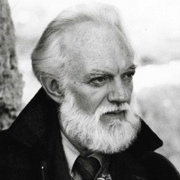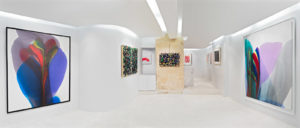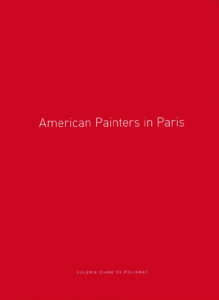
(1923-2012)
Paul Jenkins was an American abstract painter who lived between New York and Paris. After studying at the Art Students League, he became part of the Abstract Expressionist movement with Mark Rothko and Jackson Pollock. Paul Jenkins also worked with many French artists, as well as Japanese artists in the Gutai group.
Exhibitions

AMERICAN PAINTERS IN PARIS
SOLO SHOW
JANUARY 20 – MARCH 20, 2015

PAUL JENKINS
SOLO SHOW
FEBRUARY 3 – MAY 3, 2014
Publications

AMERICAN PAINTERS IN PARIS
Published by the Galerie Diane de Polignac
Exhibition Catalog
English – 40 pages

PAUL JENKINS
Published by the Galerie Diane de Polignac
Exhibition Catalog
French & English – 64 pages
The painter Paul Jenkins’ early life and artistic training
Paul Jenkins was born on 12 July 1923 in Kansas City, Missouri, in the United States. Paul Jenkins studied at the Kansas City Art Institute between 1937 and 1942—it was during this period that he worked with the ceramist James Weldon, who would have a great influence on Jenkins’ 1950s paintings. Paul Jenkins developed a passion for theatre, receiving a scholarship to attend the Cleveland Play House theatre school in Ohio, where he designed sets.
Paul Jenkins was then called up and served in the U.S. Naval Air Corps between 1943 and 1945. In 1948, he moved to New York City where he studied at the Art Students League of New York, an art school founded in 1875. It was there that he met the painters Morris Kantor and Mark Rothko. He studied under Yasuo Kuniyoshi, who encouraged him to “delve deeply into colour”. In New York, Paul Jenkins was a regular visitor to the Frick Museum, where he admired the works of Francisco de Goya, Rembrandt, William Turner, Georges de la Tour and Johannes Vermeer, from which he learned about the importance of light.
The painter Paul Jenkins’ first travels to Europe
After graduating in 1953, Paul Jenkins travelled to Italy and Spain using the benefits he received as a result of the G.I. Bill—a scholarship distributed by the U.S. government to encourage cultural exchange between the United States and Europe. Paul Jenkins then moved to Paris, where he met Jean Dubuffet, Georges Mathieu and Pierre Soulages, as well as various American artists living in Paris, including the painters Sam Francis and Lee Krasner, and the sculptor Claire Falkenstein. Paul Jenkins would divide his time between New York and Paris throughout his life. The writer Frank Anderson Trapp observed: “It is extremely interesting to note that Jenkins left the United States for Europe just as New York was being recognised as the leading centre of innovation in the visual arts.”
Working with powdered pigments that gave his oil paintings a glazed effect, Paul Jenkins developed a fascination for the works of Gustave Moreau and Odilon Redon.
In 1954, Paul Jenkins’ first solo exhibition work was held at the Studio Paul Facchetti in Paris, where Paul Jenkins met the gallery owner Martha Jackson and the artist Mark Tobey. In the same year, Jenkins’ works were shown at the Galerie Arnaud in Paris.
The painter Paul Jenkins’ success in the United States
Paul Jenkins’ first solo exhibition in the United States was held at the Zoe Dusanne Gallery in Seattle in 1955. The Seattle Art Museum bought one of his paintings at the event. In the same year, Paul Jenkins exhibited his works in group exhibitions at the Martha Jackson Gallery in New York, as well as at the Galerie Rive Droite, the Galerie Jean Lacarde and the Petit Palais in Paris. The next year was marked by the acquisition of one of Paul Jenkins’ works by the collector John I. H. Baur for the Whitney Museum of American Art and Jenkins’ participation in a group exhibition at the Museum of Modern Art in New York. In 1957, Peggy Guggenheim bought an oil on canvas by Paul Jenkins from the Stadler Gallery in Paris and donated it to the New Orleans Museum of Art.
Living in New York in 1958, the painter began work on his Eyes of the Dove series and participated in a group exhibition at the Carnegie Institute’s Museum of Art in Pittsburgh.
Paul Jenkins’ Phenomena period
After studying Goethe’s theories on colour, Paul Jenkins began work on his Phenomena series in 1960: diluting oil paint to achieve watercolour-style effects, he spread the paint over the surface of the canvas with an ivory knife. Discussing these works, Paul Jenkins said: “Have you ever seen a shark’s fin cutting through the surface of the water? It is very pretty. Beauty harbours latent violence…” Paul Jenkins began using acrylic paint as soon as it became available in the United States in the early 1960s. Describing Paul Jenkins’ approach to work—constantly inventing new techniques—the poet Alain Bosquet said: “The most original [technique] involved pouring the colours into the hollow of a sheet or canvas that he had curved. The sheet was then tilted (…) and lightly folded or unfolded, to force the colours to gather (…) and thus to find their shape. The choreography [of the work] is thus intensified by the movement of the painter.”
In 1961, the Karl Flinker Gallery presented a solo exhibition of Paul Jenkins’ works. In the same year, the publisher Editions Two Cities in Paris published the book The Paintings of Paul Jenkins, which contained texts by Kenneth B. Sawyer, James Fitzsimmons and Pierre Restany. Discussing the painter, the latter said: “Jenkins’ chromatic register disregards all visual constraints: his palette ventures far beyond the conventional limits at the upper end of the spectrum.”
Paul Jenkins met Henri Michaux in 1962—the same year that his works were presented in group exhibitions at the Louvre Museum, the Musée d’Art moderne de Paris and the Musée des Arts Décoratifs in Paris, as well as at the Whitney Museum in New York and the Rose Art Museum in Waltham, Massachusetts, in the United States. The following year works by Paul Jenkins were shown in group exhibitions at the Art Institute in Chicago and the Guggenheim Museum in New York.
In 1964, a Paul Jenkins retrospective was held at the Kestner-Gesellschaft in Hanover. The Martha Jackson Gallery produced the film The Ivory Knife: Paul Jenkins at Work, which was shown in 1966 at the Museum of Modern Art in New York and at the Venice Festival, where it received the Golden Eagle Award.
Paul Jenkins travelled to Japan—where he worked with the Gutai group and exhibited works at the Tokyo Gallery—as well as India and Russia.
In 1967, Paul Jenkins received an award for painting at the 30th Biennale of the Corcoran Gallery of Art in Washington. His play Strike the Puma, which was published the previous year, appeared on stage in New York. Paul Jenkins’ wife Suzanne Donnelly-Jenkins—who co-wrote with Paul Jenkins—explained that the play hoped “to retrace, in the form of a dance drama, the passage of colour through a prism”.
In 1968, Paul Jenkins produced a series of unique glass sculptures in Venice with the glassmaker Egidio Costantini—whom he knew through Mark Tobey.
Two retrospective exhibitions of Paul Jenkins’ work were presented in 1971: at the Houston Museum of Fine Arts and the San Francisco Museum of Art. Around the same time, a monumental sculpture by Paul Jenkins entered the collections of the Cooper-Hewitt Museum in New York.
The monograph Paul Jenkins was published in 1973 by Harry N. Abrams in New York. The artist made his first designs for the Mandala Meditation Sundial, a bronze sculpture project that was completed four years later by the Tallix Foundry in New York.
Paul Jenkins’ Prismes period
Paul Jenkins began studying Newton’s prism in 1976, exploring the effects of transparency and opacity. In the following year, Paul Mazursky shot An Unmarried Woman in Jenkins’ studio in New York. The artist was working on a series of autobiographical collages at the time. The Anatomy of a Cloud series, which featured collages, paintings and sculptures, was exhibited at the Gimpel Weitzenhoffer Gallery in New York in 1978.
During an extended trip to the Caribbean in 1979, Paul Jenkins experimented with more thickly painted works. The painter began employing an impasto technique, laying colours on the canvas in thick layers and then etching into the paint to reveal the colours layered underneath. Known for regularly reinventing his techniques, Paul Jenkins noted that: “It’s not the technique that matters. Technique is only the grammar of intention, thoughts and ideas (…) But first there is sensation, both perceptive and receptive. And with sensation comes the experience of discovering and knowing what one does not have time to explain in the moment.”
A retrospective of Paul Jenkins’ work was held at the Palm Springs Desert Museum in 1981. A piece by Paul Jenkins was acquired by the Fonds National d’Art Contemporain, a public collection under the management of the French Ministry of Culture and Communication. In 1983, the artist was made a Commander of the French Order of Arts and Letters for services to French art. His autobiography, entitled Anatomy of a Cloud, was published by Harry N. Abrams in New York and Paul Jenkins received a medal from the Art Directors Club.
In 1986, Paul Jenkins wrote a choreographic piece, Shaman to the Prism Seen, which was performed the following year at the Paris Opera. Paul Jenkins created canvases, sets and costumes for the production.
A retrospective exhibition was presented at the Musée Picasso in Antibes in the same year. Paul Jenkins created set decorations in silk for a production at the Great Hall of the People in Beijing. He also painted six 18 x 5 m banners, a 20 x 25 m canvas, and a series of 10 x 1 m banners for the Great Wall of China in 1988.
The Palais des Beaux-Arts in Lille held a retrospective exhibition of Paul Jenkins’ work in 2005. Jenkins’ works also featured in the exhibition Under Each Other’s Spell: Gutai and New York at the Pollock-Krasner House & Study Center in Springs, New York, in 2009. Solo exhibitions were presented at the Crocker Art Museum in Sacramento in 2010 and at the Museo di Pittura Murale in Prato (Italy) in 2014.
Paul Jenkins passed away in New York in 2012. His archives, including many photographs taken by his wife, were transferred to the American Art Archives at the Smithsonian Institution in Washington, D.C., in 2010—the archives contained more than 6,000 pieces.
© Diane de Polignac Gallery
Translation: Lucy Johnston

Selected collections
Selected collections
Albany, NY, Empire State Plaza
Amsterdam, Stedelijk Museum
Antibes, Musée Picasso
Arles, Fondation Van Gogh
Austin, TX, University of Texas, James A. Michener Collection
Baltimore, MD, Baltimore Museum of Art
Boston, MA, Museum of Fine Arts
Buffalo, NY, Albright-Knox Art Gallery
Canberra, Australian National Gallery
Castellaras-le-vieux (Alpes-Maritimes, France), David Douglas Duncan Collection
Corpus Christi, TX, South Texas Institute for the Arts
Dunkirk, Lieu d’Art et Action Contemporaine (LAAC)
Kansas City, TX, Nelson-Atkins Museum of Art
London, Tate Gallery
London, Victoria and Albert Museum
Los Angeles, CA, Los Angeles County Museum of Art
Milwaukee WI, Milwaukee Art Museum
Montreal, Montreal Museum of Fine Arts
Munich, Alte Pinakothek
New Orleans, LA, New Orleans Museum of Art
New York, NY, Museum of Modern Art (MoMA)
New York, NY, Solomon R. Guggenheim Museum
New York, NY, Whitney Museum of American Art
Nice, Musée d’Art Moderne et d’Art Contemporain (MAMAC)
Norfolk, VA, Chrysler Museum of Art
Osaka, National Museum of Art
Palm Springs, CA, Palm Springs Desert Museum
Paris, Musée National d’Art Moderne – Centre Georges Pompidou
Paris, Fonds National d’Art Contemporain (FNAC)
Sacramento, CA, Crocker Art Museum
Saint-Paul-de-Vence, Fondation Maeght
San Diego, CA, San Diego Museum of Art, donated by Peggy Guggenheim
San Francisco, CA, San Francisco Museum of Art, donated by the painter Sam Francis
Seattle, Seattle Art Museum
Stuttgart, Staatsgalerie
Tel Aviv, Tel Aviv Museum of Art
Tokyo, The National Museum of Western Art
Toronto, Art Gallery of Ontario
Vienna, Albertina Museum
Washington, D.C., Hirshhorn Museum and Sculpture Garden, Smithsonian Institution
Washington, D.C., Smithsonian American Art Museum
Washington, D.C., National Gallery of Art
Selected exhibitions
Selected exhibitions
Studio Paul Facchetti, Paris, 1954
Zimmergalerie Franck, Frankfurt, 1954
Zoe Dusanne Gallery, Seattle, 1954
Martha Jackson Gallery, New York, 1956, 1958, 1960, 1961, 1964, 1966, 1968, 1970, 1971, 1973
Galerie Stadler, Paris, 1957
Arthur Tooth & Sons, London, 1958, 1960, 1963
Esther Robles Gallery, Los Angeles, 1960, 1962
Gallery of Realities, Taos (New Mexico, United States), 1960
Galerie Karl Flinker, Paris, 1961, 1962, 1965, 1973, 1976, 1980
Abstract Expressionists and Imagists, Solomon R. Guggenheim Museum, New York, 1961
Galerie Lienhard, Zurich, 1962
Galleria Toninelli, Milan, 1962
Galleria Odyssia, Rome, 1962
Kunstverein, Cologne, 1962
Eva de Buren Gallery, Stockholm, 1963
Tokyo Gallery, Tokyo, 1964
Court Gallery, Copenhagen, 1964
Kumar Gallery, New Delhi, 1964
Kestner-Gesellschaft, Hanover (retrospective exhibition), 1964
Gertrude Kasle Gallery, Detroit, 1965, 1970
Galerie Agnès Lefort, Montreal, 1966
Hope Makler Gallery, Philadelphia, 1966
Gallery of Modern Art, Scottsdale, 1966
Galerie Daniel Gervis, Paris, 1968
Gallery Moos Ltd, Toronto, 1968, 1985
Galerie Räber, Lucerne, 1968
Richard Gray Gallery, Chicago, 1971
Suzanne Saxe Gallery, San Francisco, 1971
Paul Jenkins Retrospective, Museum of Fine Arts, Houston, 1971
Paul Jenkins Retrospective, San Francisco Museum of Art, San Francisco, 1972
Images Gallery, Toledo, 1972
Abstract Expressionism, Albright-Knox Gallery, Buffalo, 1972
Gimpel Fils Gallery, London, 1972, 1974, 1980, 1982, 1986
Abrams Original Editions, New York, 1972
Corcoran Gallery of Art, Washington, 1972
Oklahoma Art Center, Oklahoma City, 1973
Santa Barbara Museum of Art, Santa Barbara, 1973
Indianapolis Museum of Art, Indianapolis, 1973
Musée des Beaux-Arts, Charleroi (Belgium), 1974
Baukunst, Cologne, 1974, 1979
Hunter Museum of Art, Chattanooga (Tennessee), 1974
Lauren Rogers Library and Museum of Art, Laurel (Mississippi), 1975
Tampa Bay Art Center, Tampa (Florida), 1974
Montgomery Museum of Fine Arts, Montgomery (Alabama), 1974
Galerie Cour Saint-Pierre, Geneva, 1977
Philbrook Art Center, Tulsa (Oklahoma), 1977
Galleria d’Arte Narciso, Turin, 1978
Elaine Horwitch Gallery, Scottsdale (Arizona), 1979, 1980, 1986
Retrospective, Palm Springs Desert Museum, Palm Springs, 1981
Hommage à Jean-Louis Barrault, French Cultural Services of the French Embassy, New York, 1981
Maison Internationale du Théâtre, Théâtre du Rond-Point, Paris, 1981
Mead Art Museum, Amherst (Massachusetts), 1983
Alex Rosenberg Gallery, New York, 1983
Lieu d’Art et Action Contemporaine (LAAC), Dunkirk, 1984
Galleri Art Atrium, Stockholm, 1985
Gallery Art Point, Tokyo, 1986
Paul Jenkins, œuvres majeures, Musée Picasso, Antibes, 1987
Galerie Régis Dorval, Lille, 1987
Galerie Patrice Trigano, Paris, 1988
Gana Gallery, Seoul, 1988
Paul Jenkins, œuvres majeures, Palais des Beaux-Arts, Lille, 2005
Un Art Autre autour de Michel Tapié, Christie’s Paris, 2012
Paul Jenkins, Diane de Polignac Gallery, Paris, 2014
Selected bibliography
Selected bibliography
Ferdinand Louis Berckelaers, Dictionary of Abstract Painting, New York, Tudor, 1957
Various, Dictionary of Abstract Painting with a History of Abstract Painting, New York, Paris Book Center, 1958
Kenneth B.Sawyer and Pierre Restany, The Paintings of Paul Jenkins, Paris, Two Cities, 1961
Ein Halbes Jahrhundert abstrakte Malerei, Munich and Zurich, Droemer-Knaur, 1962
Jean Cassou, Jenkins, Paris, published by the Galerie Karl Flinker, Paris, 1963
Juan-Eduardo Cirlot, “The World of Paul Jenkins”, Studio, Vol. 165, No. 839, March 1963
George P. Elliot, Lascaux and Jenkins, 14 Poems, Lanthem, Maryland, Goosetree Press, 1964
Paul Cummings, A Dictionary of Contemporary American Artists, New York, St. Martin’s Press, 1966
Jean Cassou et Paul Jenkins, Jenkins : Dialogue entre Paul Jenkins et Jean Cassou, Paris, Éditions de la Galerie Karl Flinker, 1967
H. H. Arnason, History of Modern Art, New York, Harry N. Abrams, 1968
Gerald Nordland, Paul Jenkins, New York, Universe Books with the Houston Museum of Fine Arts and the San Francisco Museum of Art, 1971-1972
Albert Edward Elsen, Paul Jenkins, Paris, Éditions Horay, 1973
Gérard Barrière, “Phénomène : notes sur les peintures de Paul Jenkins”, Opus, No. 89, Paris, 1973
Albert E. Elsen, Paul Jenkins, New York, Harry N. Abrams, 1973
Albert Edward Elsen, Paul Jenkins, New York, Abrams, 1974
Michel Seuphor, L’Art Abstrait, Paris, Maeght Editeur, 1974
J. Flam, “Paul Jenkins and the Aesthetics of Risk”, Arts, Vol. 50, No. 2, October 1975
Michel Conil-Lacoste, Phenomena – Paul Jenkins, Galerie Karl Flinker, Paris, 1976
Irving Sandler, The New York School, New York, Harper & Row, 1978
Mario Amaya, Paul Jenkins, Interview, Vol. 9, No. 9, September 1979
Matthew Baigell, Dictionary of American Art, New York, Harper & Row, 1979
Pierre Cabanne, Dictionnaire des Arts, Paris, Bordas, 1979
E. R. Firestone, “Herman Melville’s Moby Dick and the Abstract Expressionists”, Arts, Vol. 54, March 1980
Ronald Alley, Catalogue of the Tate Gallery’s Collection of Modern Art: Other Than Works by British Artists, London, Sotheby Parke Bernet in association with the Tate Gallery, 1981
Alain Bosquet, Paul Jenkins, Paris, Georges Fall, 1982
Paul Cummings, “Anatomy of a Cloud, Drawing”, New York, The Drawing Society, Vol. V, No. 5, January–February 1984
Various, The Painting and Sculpture Collection, New York, Hudson Hills Press in association with the San Francisco Museum of Art, 1985
Robert McVaugh, Twentieth Century Painting from the Solomon R. Guggenheim Museum: Abstraction, Non-Objectivity, Realism, Hamilton, The Picker Art Gallery, 1987
Various, Paul Jenkins, œuvres, catalogue for the exhibition at the Musée Picasso in Antibes from 18 May to 28 June 1987, Antibes, 1987
Pierre Restany, “La Couleur, la Lumière et le Chamane”, Cimaise, No. 190, September–October 1987
Françoise Armengaud, Titres, Paris, Meridiens Klincksieck, 1988
Patrick-Gilles Persin, “Jenkins”, Cimaise, No. 193, April–May 1988
Lydia Harambourg, L’Ecole De Paris, 1945-1965 : Dictionnaire Des Peintres, Lausanne, Ides et Calendes, 1993
Lydia Harambourg, L’École de Paris, 1945-1965, Dictionnaire des peintres, Ides et Calendes, Neuchâtel, 1993, (update by Clotilde Scordia, Ides et Calendes, Neuchâtel, 2010)
Paul Jenkins, exhibition catalogue, Galerie Diane de Polignac, Paris, 2014
Paul Jenkins Faq
On the PAUL JENKINS FAQ page, find all the questions and answers dedicated to the modern art painter Paul Jenkins.


